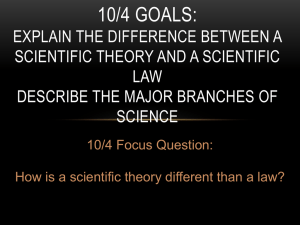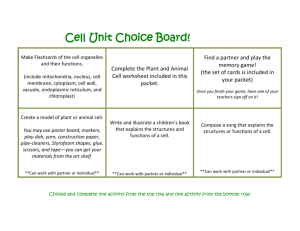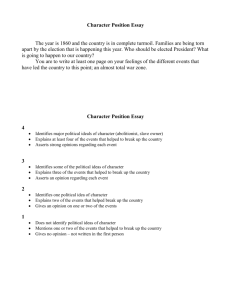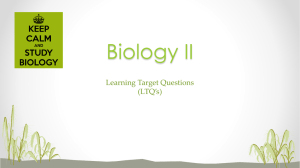8 th Grade Physical Science - Assumption St Bridget School
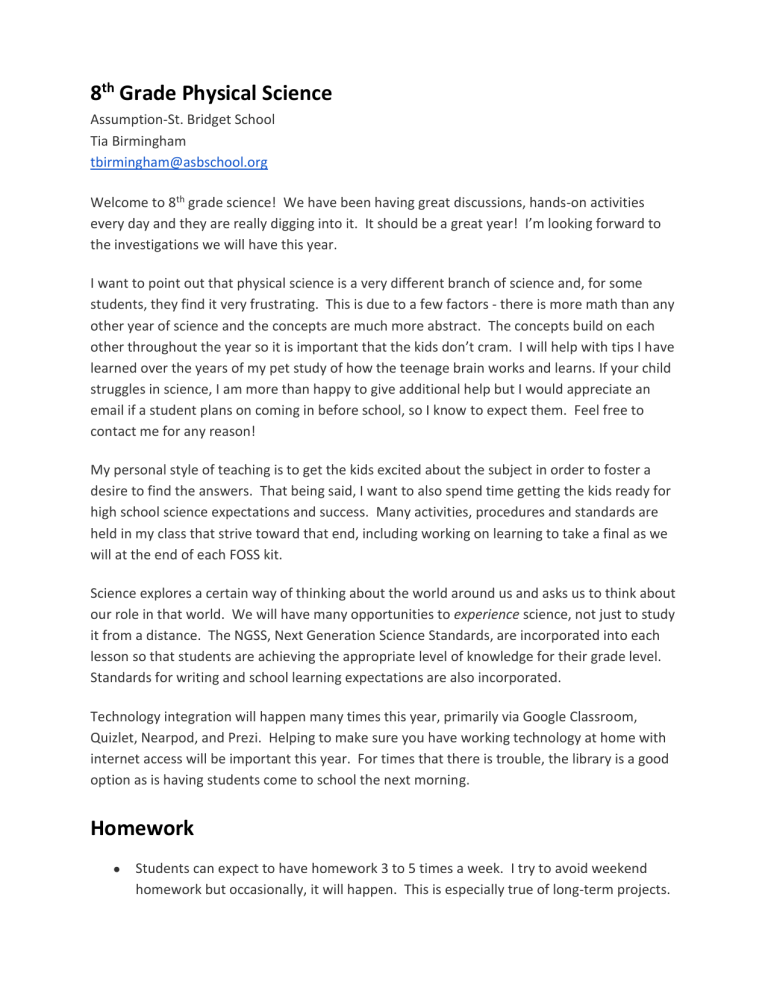
8
th
Grade Physical Science
Assumption-St. Bridget School
Tia Birmingham tbirmingham@asbschool.org
Welcome to 8 th grade science! We have been having great discussions, hands-on activities every day and they are really digging into it. It should be a great year! I’m looking forward to the investigations we will have this year.
I want to point out that physical science is a very different branch of science and, for some students, they find it very frustrating. This is due to a few factors - there is more math than any other year of science and the concepts are much more abstract. The concepts build on each other throughout the year so it is important that the kids don’t cram. I will help with tips I have learned over the years of my pet study of how the teenage brain works and learns. If your child struggles in science, I am more than happy to give additional help but I would appreciate an email if a student plans on coming in before school, so I know to expect them. Feel free to contact me for any reason!
My personal style of teaching is to get the kids excited about the subject in order to foster a desire to find the answers. That being said, I want to also spend time getting the kids ready for high school science expectations and success. Many activities, procedures and standards are held in my class that strive toward that end, including working on learning to take a final as we will at the end of each FOSS kit.
Science explores a certain way of thinking about the world around us and asks us to think about our role in that world. We will have many opportunities to experience science, not just to study it from a distance. The NGSS, Next Generation Science Standards, are incorporated into each lesson so that students are achieving the appropriate level of knowledge for their grade level.
Standards for writing and school learning expectations are also incorporated.
Technology integration will happen many times this year, primarily via Google Classroom,
Quizlet, Nearpod, and Prezi. Helping to make sure you have working technology at home with internet access will be important this year. For times that there is trouble, the library is a good option as is having students come to school the next morning.
Homework
● Students can expect to have homework 3 to 5 times a week. I try to avoid weekend homework but occasionally, it will happen. This is especially true of long-term projects.
●
●
●
●
When students come to class, assignments are to be turned in within the first few minutes or they are late. If we are working with the material right away, I will send them to the hall to finish work and ask them to see me at recess or after school study hall to make up what they missed during classtime. (Please see that handout – they have it in their notebooks.) The most important reason for this is so that students stay focused on class content and are not trying to finish work during class.
Sometimes, homework will be assigned reading with notes in their notebook. When this is the assignment, they MUST have it completed by class time. If they are unprepared, they are going to struggle through the whole class. If notes are not done, they still need to do them so that they have the subject matter read and reinforced. If a student is not prepared often, I will contact you quickly to nip the problem before it damages grades too much.
Students should do their own work – help them, but please do not do it for them. The same goes for study groups – if students get together to work on an assignment, make sure that they are not just swapping answers.
If students miss a lab due to an absence, they will need to schedule coming in to make this up. I maintain a page on our website where I list what we do in class and what they need to do - I ask students to check there before coming to me. I also keep print-outs of class notes in a binder that students may access at any study hall. This can be for absences OR because soemthing went too fast in class.
Grading
Grading in science this year will be standards based, using the school-wide approved scale.
Please see the standards that follow at the end of this document. Students are striving to meet standard (3). The “exemplary” rating (4) is very difficult to attain. It is reserved for assignments whose quality of answers, scientific support, and critical thinking go well beyond what is typically seen by their peers.
Curriculum Topics for 8
th
Grade: Physical Science
★
Introduction to inquiry investigations
★
Lab tools and metric system
★
Structure & Properties of Matter
★
Chemical structure of matter and interactions
★
Elements, Mixtures, & Compounds
★
Chemical reactions
★
Force & Motion
★
Energy & waves
8 th Grade Physical Science Standards
1. Structure and Properties of Matter
1A. Describes the characteristic properties of substances and that these properties can be used to identify substances.
1B. Explains how matter is made of smaller particles and that matter is conserved in a closed system.
1C. Explains how atoms are made of particles of varying sizes and uses the periodic table to determine their properties, including how atoms will bond with each other.
1D. Describes behaviors and traits of gases, liquids, and solids relative to each other.
1E. Explains and/or predicts how temperature or pressure changes cause changes in states.
1F. Describes attractive forces, such as gravity and magnetism, and the relationships between attractive forces, mass, and distance.
2. Chemical Reaction
2A. Explains how substances react chemically in characteristic ways; can point to evidence that shows reactions have changed starting substances into new substances.
2B. Analyze and interprets data on the properties of substances before and after the substances interact to determine if a chemical reaction has occurred.
2C. Explains how the atoms that make up original substances regroup during chemical reactions to form different substances with new properties.
2D. Explains how atoms bond to form compounds and mass is conserved.
2E. Names and describes energy changes due to chemical reactions.
3. Energy & Waves
3A. Predicts and describes changes in particle motion, temperature, and state of a pure substance when thermal energy is added or removed.
3B. Names and describes forms of energy and explains heat in scientific terms.
3C. Explains how different forms of energy are transferred and transformed and describes the role of heat in energy transfer.
3E. Explains and applies the Law of Conservation of Energy in terms of potential energy, kinetic energy, and work.
3F. Explains how molecular motion and electromagnetic radiation are involved in the transfer of thermal energy.
4. Forces & Motion
4A. Uses evidence to support the claim that gravitational interactions are attractive and depend on the masses of interacting objects.
4B. Explains how balanced and unbalanced forces affect the motion of an object.
4C. Describes how position and size of force affect the motion of an object and explains energy transfers between force interactions.
4D. Applies Newton’s Laws of motion when solving problems.
4E. Explains how electric and magnetic forces can be attractive and repulsive and describe the variables that affect the size and stranth of the force.
5. Processes, Systems, Inquiry, Application
5A. Demonstrates scientific thinking to simplify and analyze complex situations.
5B. Plans, carries out, analyzes, and communicates the findings of a scientific investigation.
5C. Explains the purpose and limitations of a model while also developing and using models.
5D. Explains the role of technology and science in solving human problems.
5E. Uses accurate mathematical and computational thinkinging in problem solving.
5F. Obtains, evaluates, and communicates information.
5G. Engages in argument from evidence.

